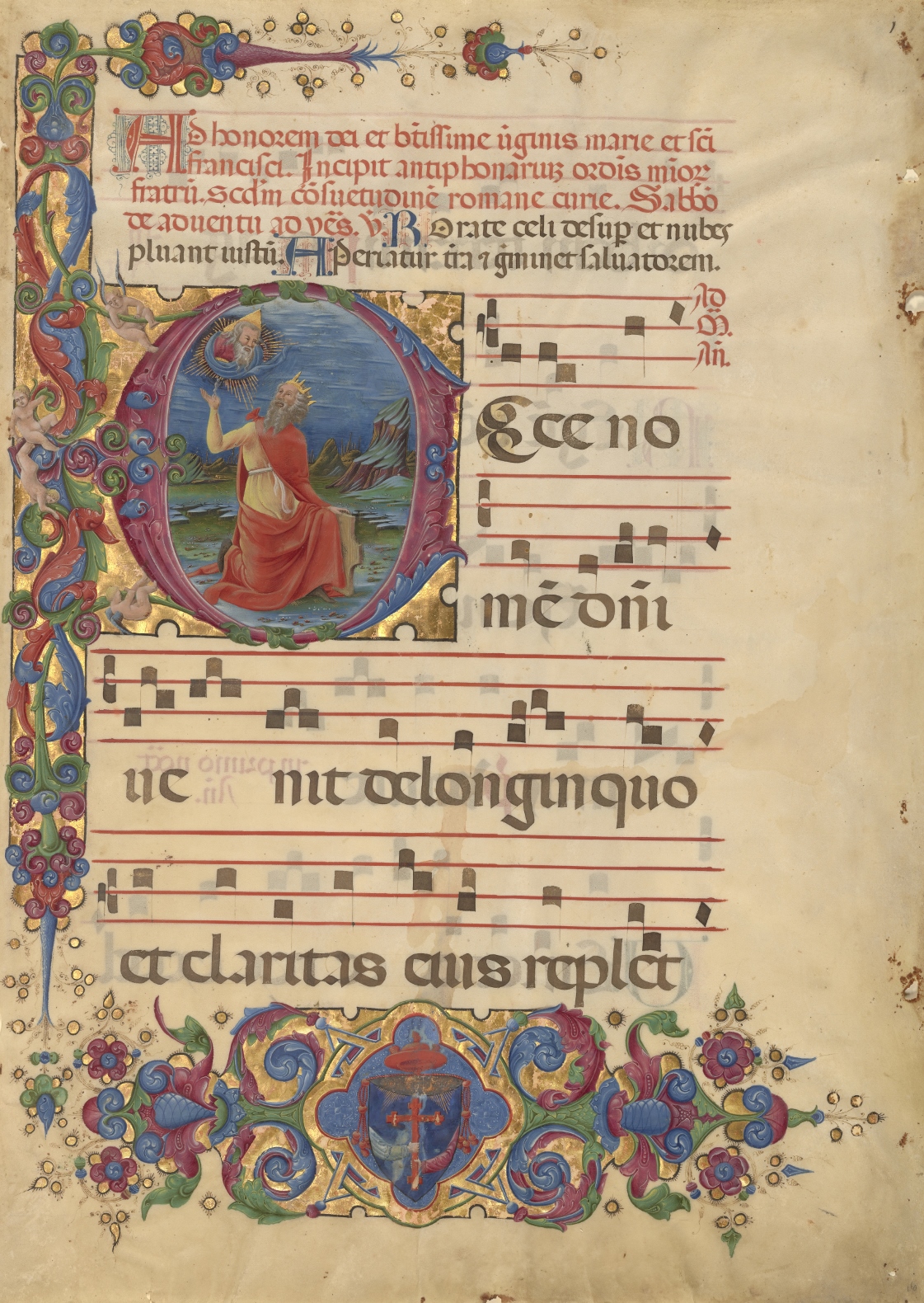
Initial E: David Lifting Up His Soul to the Lord from the Antiphonal of Cardinal Bessarion, Franco dei Russi, about 1455-60/63. The J. Paul Getty Museum, Ms. 99
A newly launched virtual exhibition brings together over 100 manuscript pages from the northern Italian Renaissance. The site complements Renaissance Splendors of the Northern Italian Courts, now on view at the Getty Center, which presents manuscript illuminations made for princes, prelates, and other courtiers of northern Italian cities including Milan and Venice.
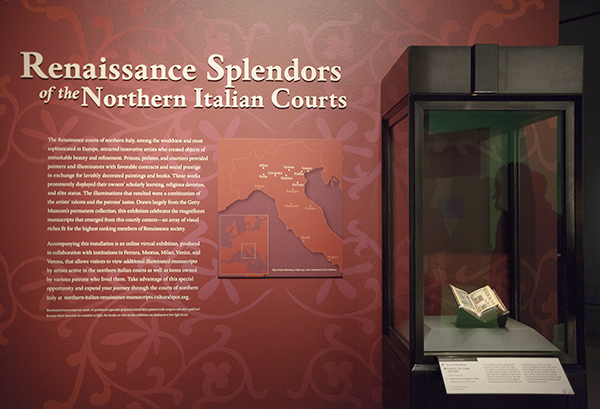
In the physical exhibition, visitors can come face to face with majestic illuminations such as the biblical King David shown at the top of this post, featured on a page from an imposing, over-two-feet-tall antiphonary (choir book for daily prayer services). Six additional pages from the original manuscript—long since disbound and dispersed—are reunited online through the virtual exhibition.
Set within an otherworldly landscape, this quiet scene of pious devotion was once part of the first volume of the 18-volume Antiphonary of Cardinal Bessarion. Commissioned by Cardinal Bessarion of the Byzantine church, the antiphonary volumes were initially intended for a Franciscan church in Constantinople. But they remained in Italy at the church of Santa Maria dell’Osservanza in Cesena, where some of the tomes remain to this day. Additional volumes and dispersed pages from the manuscripts can be found in museums and private collections around the world, including three leaves in the Getty Museum’s collection.
Fascinating histories such as these prompted us, the exhibition’s co-curator and designer, to create the virtual exhibition. We chose Google Open Gallery as our platform because of its streamlined interface and powerful image-comparison features.
Curating a Virtual Exhibition
Produced in collaboration with libraries, archives, and museums in the Italian cities of Ferrara, Mantua, Milan, Venice, and Verona, the virtual exhibition is a curated experience that greatly expands the scope and range of objects on view at the Getty. The site invites anyone with an internet connection to view, in one place, about 100 illuminated manuscripts, panel paintings, and other objects by artists active in the northern Italian courts as well as items owned by various patrons who lived there.
A major partner in this project is the Archivio Storico e Biblioteca Trivulziana in Milan, which is displaying a physical exhibition under the same title (Splendori rinascimentali nelle corti dell’Italia settentrionale).

Installation view at Archivio Storico e Biblioteca Trivulziana, Milan.
We’d like to share what we’re most excited about in the new virtual exhibition and point out seven highlights we invite you to explore.
1. Dive into courtly intrigue and artist-patron relationships
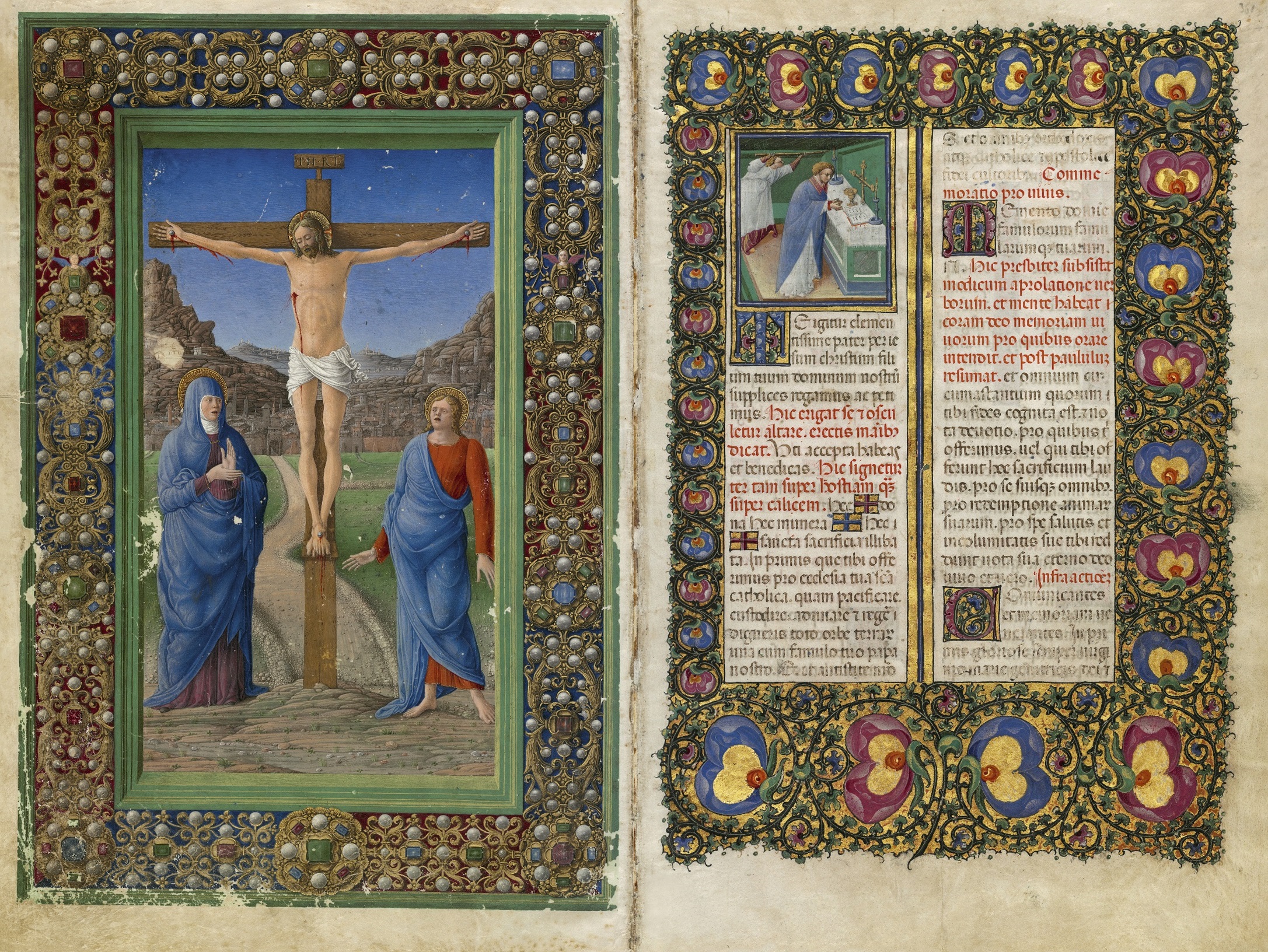
The Crucifixion; A Priest Celebrating Mass from Missal of Barbara of Brandenburg Gonzaga, Girolamo da Cremona (left) and Belbello da Pavia (right), 1442-65. Mantua, Archivio Storico Diocesano, Ms. s.s., fols. 182v-183 (Photo: Roberto Bini for the facsimile edition, © Il Bulino edizioni d’arte, Italy)
A remarkable story of artistic rivalry and political machinations is revealed inside this single manuscript.
In the mid-1400s, artist Belbello da Pavia was relieved of a prestigious manuscript commission for the marchioness consort of Mantua, Barbara of Brandenburg Gonzaga. Why? Old age, a slow working pace, a patron’s changing taste in style, and the artist’s conviction on charges of sodomy are all likely factors.
As archival documents tell us, Girolamo da Cremona, “a youth from that region who illuminates very well,” picked up the commission at the recommendation of official court painter Andrea Mantegna. This story is hinted at in the Getty galleries, but online you can dive deeper into the actual manuscript that lost Belbello his job and established Girolamo’s reputation at the court of Mantua.
2. Compare dispersed pages from the same multi-volume manuscript

Initial H: An Angel Carrying the Cross from Antiphonal, Belbello da Pavia, about 1467–70. Venice, Abbazia di San Giorgio Maggiore, Antiphonal M, fol. 74
The majority of the objects in the exhibition at the Getty are leaves (single pages) or cuttings (parts of pages) from choir books. This is the result of the practice of repurposing manuscripts whose contents had become outmoded, one that began in the 18th and 19th centuries.
The virtual exhibition digitally reunites pages from several such dispersed manuscripts, including the Antiphonal of Carinal Bessarion mentioned earlier, a set of choir books from Venice illuminated by a team of artists including Belbello da Pavia (after he left Mantua), and a pair of leaves decorated by Cristoforo Cortese.
3. Compare works thought to have been painted by the same artist

Left: Attributed to Pisanello and the Master of the Antiphonal Q of San Giorgio Maggiore, The J. Paul Getty Museum, Ms. 41, verso. Right: Master of the Antiphonal Q of San Giorgio Maggiore, Fondazione Giorgio Cini, Venice, Inv. 2112
The past practice of cutting up illuminated manuscripts has led to many irreparable holes in the art historical record. When orphaned fragments exist without their parent manuscripts, for example, it can be difficult to reconstruct the full story of artists’ collaboration on a single commission. Leaves and cuttings from single books now exist across numerous collections, making it extremely complicated to reassemble them.
One important feature of the online exhibition is the ability to digitally compare minute details in two works attributed to the same artist and to question whether the works are in fact by the same hand—or whether they are simply related or similar.
4. Study signed and unsigned works by an artist’s workshop

Christ in Majesty with the Symbols of the Four Evangelists from Missal of Gian Galeazzo Visconti, Anovelo da Imbonate, early 1400s. Archivio e Biblioteca Capitolare di Sant’Ambrogio, Milan, Ms. M. 6, fol. 153v (© Archivio Capitolare Basilica S. Ambrogio, photo: Vittorio Calore)
During the Renaissance, remarkably few artists signed their work. In the exhibition at the Getty, only one object bears the signature of its maker: Giovanni Antonio Decio. Online, it’s possible to see his work side by side with other objects by the Decio family.
The virtual exhibition also includes a stunning manuscript illuminated by the Milanese artist Anovelo da Imbonate and produced for the first duke of Milan, Gian Galeazzo Visconti (reigned 1395-1402). A manuscript attributed to Anovelo, known as The Legend of the Venerable Men Aimo and Vermondo, is featured in the Getty exhibition, and the virtual platform allows you to analyze a page from this manuscript alongside its twin, a closely related copy now in the Trivulziana Library in Milan.
5. Compare works in different media attributed to the same artist

Left: Madonna of the Rose Garden, Stefano da Verona, about 1420. Museo di Castelvecchio, Verona, Inv. 173-1B0359 (Per gentile concessione della Direzione Musei d’Arte Monumenti di Verona). Right: Initial A: Pentecost, attributed to Stefano da Verona, about 1430-35. The J. Paul Getty Museum, Ms. 95, recto
Stefano da Verona is one of the artists whose work is represented in the virtual exhibition across both panel painting and manuscript illumination. His work is characterized by a refined sense of line, harmonious colors, and softly modeled figures. Look for other cross-media comparisons for the works of Pisanello, Cosmè Tura, Francesco di Giorgio Martini, Girolamo dai Libri, Andrea Mantegna, and Giulio Romano.
6. Explore a single object in greater depth

Scenes from the Book of Genesis from the Bible for the Certosa of St. Christopher in Ferrara, Guglielmo Giraldi, before 1469–about 1476. Ferrara, Museo di Schifanoia, Musei Civici di Arte Antica, OA 1346 (volume I), fol. 7v (Ferrara, Fototeca dei Musei Civici di Arte Antica)
An exhibition of manuscripts allows visitors to view only a single opening (pair of pages) from a book. Yet many illuminated manuscripts are richly decorated throughout. The virtual exhibition presents several pages of such manuscripts, like the Bible for the Certosa of St. Christopher in Ferrara.
7. Encounter exquisite works from private collections in a broader context

Left: Initial A: The Ascension, Attributed to Turone di Maxio, about 1356-87. Private collection, San Francisco; Right: Initial G: The Birth of the Virgin, Master of the Murano Gradual, second quarter of the 15th century. Collection of Robert McCarthy
An arresting array of vibrant colors and brilliant gold fill this stunning illumination by Turone di Maxio (above left) and create a prismatic viewing experience as impressive today as when it was painted over 600 years ago. This miniature joins a signed altarpiece by Turone in the virtual exhibition, allowing close viewing of details like scrolling vines, acanthus leaves, and use of bright hues. Similarly, the scene of the birth of the Virgin (above right) is paired at the Getty and online with other miniatures by the same artist, the Master of the Murano Gradual, an artist who paid particular attention to expression, weight, and physiognomic detail. These characteristics can be viewed in hi-res, side by side, online.
8. Gain insight into artist collaboration in a single manuscript

The Crucifixion and Scenes from the Passion; Initial T: A Priest Celebrating Mass and The Lamentation, from the Missal of Ercole I d’Este, Martino da Modena with Giorgio d’Alemagna and Bartolomeo del Tintore, 1470. Milan, Archivio Storico Civico e Biblioteca Trivulziana, Cod. Triv. 2165, fols. 190v-191
Some manuscripts were illuminated by multiple artists working in collaboration. This one, for example, is the product of two or possibly three hands.
Artist Martino da Modena trained in the art of illumination under his father, Giorgio d’Alemagna, a highly revered artist at the Este court of Ferrara. This missal, a service book containing the readings for mass, was commissioned for Duke Ercole I d’Este (reigned 1471–1505) and was illuminated by da Modena, possibly with some intervention by his father. A third artist, Bartolomeo del Tintore, may have painted the stunning Crucifixion.
Exhibition Teamwork

The Annunciation and Initial D: The Virgin and Child from Gualenghi-d’Este Hours, Taddeo Crivelli (left) and Guglielmo Giraldi (right), about 1469. The J. Paul Getty Museum, Ms. Ludwig IX 13, fols. 3v-4
Illuminated manuscripts were by their very nature collaborative undertakings, involving illuminators, parchment makers, scribes, pigment suppliers, workshop assistants, book binders, even diplomats and courtly advisors. So too are museum exhibitions.
The exhibition Renaissance Splendors was conceived by former graduate intern Christopher Platts, who co-curated the show with Bryan Keene of the manuscripts department, and was brought to life in the Getty galleries thanks to the hard work and talent of colleagues from numerous departments across the Museum.
Exhibitions in museum galleries invite visitors to experience the beauty, size, texture, and aura of artworks in a physical way. The virtual exhibition complements and extends that experience by bringing related works together online, making accessible the results of international curatorial collaboration. We hope it will serve as a lasting resource for scholars, professors, students, and anyone interested in books, history, or the European Renaissance.
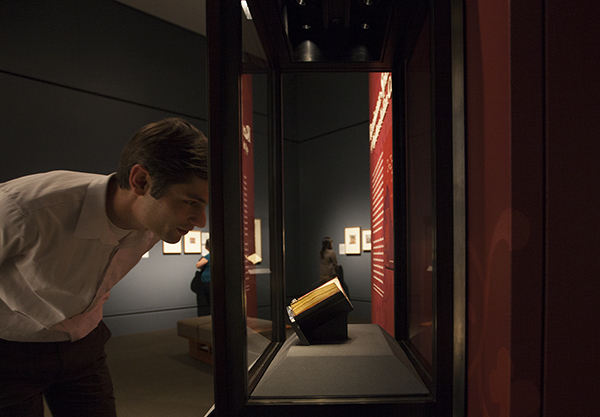
_______
Partner Institutions for the Virtual Exhibition
Abbazia di San Giorgio Maggiore, Venice (Carmelo Grasso, Abbot Norberto Villa, and the Benedictine community)
Archivio e Biblioteca Capitolare di Sant’Ambrogio, Milan (Marco Petoletti and Miriam Tessera)
Archivio Storico Civico e Biblioteca Trivulziana, Milan (Claudio Salsi, Isabella Fiorentini and Marzia Pontone)
Archivio Storico Diocesano, Mantua (Mons. Giancarlo Manzoli, Licia Mari and Mauro Bini)
Fondazione Cini, Venice (Luca Massimo Barbero, Alessandro Martoni and Simone Guerriero)
Musei civici di Arte Antica, Ferrara (Elena Bonatti and Giovanni Sassu)
Museo di Castelvecchio, Verona (Paola Marini, Ettore Napione and Arianna Strazieri)
Private collections, United States and United Kingdom

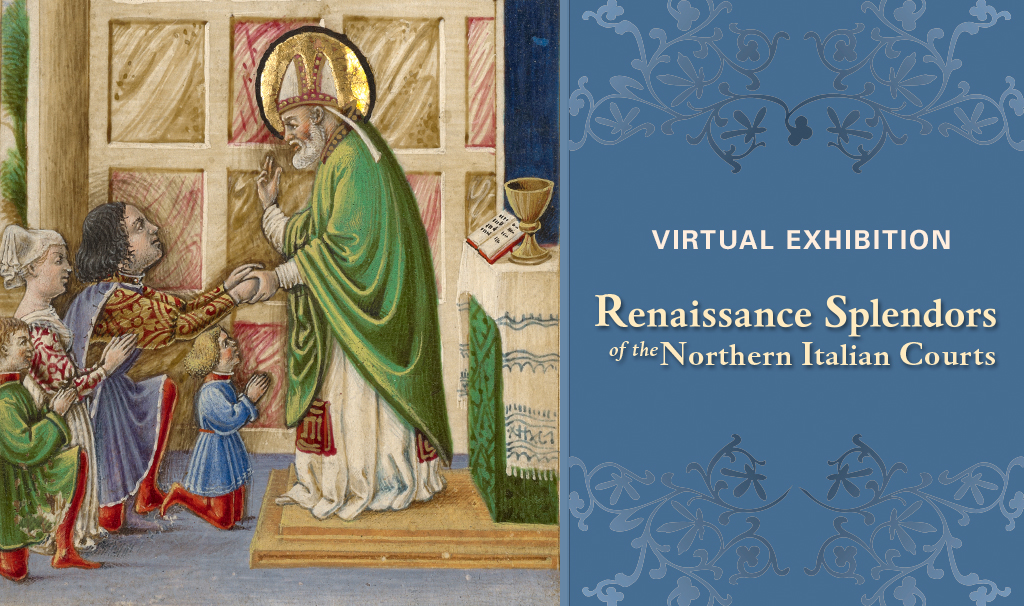
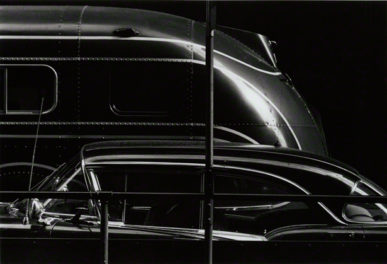
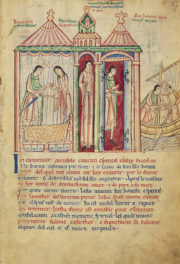

Thanks, this is a fantastic resource!
Thank you for sharing this precious info!